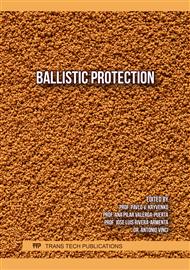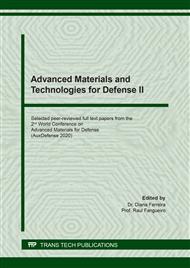[1]
M. Shekarchi, A. Rafiee, H. Layssi, Long-term chloride diffusion in silica fume concrete in harsh marine climates, Cement and Concrete Composites 31 (10) (2009) 769-775.
DOI: 10.1016/j.cemconcomp.2009.08.005
Google Scholar
[2]
J. H. Gonzalez-Libreros, C. Sabau, L. H. Sneed, C. Pellegrino, G. Sas, State of research on shear strengthening of RC beams with FRCM composites, Construction and Building Materials 149 (2017) 444-458.
DOI: 10.1016/j.conbuildmat.2017.05.128
Google Scholar
[3]
S. Mishra, H. K. Sharma, Impact Resistance and Mechanical Properties of UHPFRC, in: Iranian Journal of Science and Technology - Transactions of Civil Engineering, Vol. 43, Springer International Publishing, 2019, pp.371-380.
DOI: 10.1007/s40996-018-0196-y
Google Scholar
[4]
J. J. Schuldies, R. Nageswaran, Ceramic matrix composites for ballistic protection of vehicles and personnel, in: Blast Protection of Civil Infrastructures and Vehicles Using Composites, Elsevier Ltd., 2010, pp.235-243.
DOI: 10.1533/9781845698034.2.235
Google Scholar
[5]
D. J. Carr, Failure mechanisms of yarns subjected to ballistic impact, Journal of Materials Science Letters 7 (18) (1999) 585-588.
Google Scholar
[6]
S. N. A. Safri, M. T. H. Sultan, M. Jawaid, K. Jayakrishna, Impact behaviour of hybrid composites for structural applications: A review, Composites Part B: Engineering 133 (2018) 112-121.
DOI: 10.1016/j.compositesb.2017.09.008
Google Scholar
[7]
E. Wilusz, Military Textiles, Woodhead Publishing, Cambridge, (2008).
Google Scholar
[8]
T. Uomoto, T. Nishimura, Deterioration of Aramid, Glass, and Carbon Fibers Due to Alkali, Acid, and Water in Different Temperatures, Special Publication 188 (1999) 515-522.
DOI: 10.14359/5650
Google Scholar
[9]
P. Böer, L. Holliday, T. H. Kang, Independent environmental effects on durability of fiberreinforced polymer wraps in civil applications: A review (2013).
DOI: 10.1016/j.conbuildmat.2013.06.077
Google Scholar
[10]
C. Signorini, A. Nobili, F. O. Falope, Mechanical performance and crack pattern analysis of aged Carbon Fabric Cementitious Matrix (CFRCM) composites, Composite Structures.
DOI: 10.1016/j.compstruct.2018.05.052
Google Scholar
[11]
ACI 549.4R-13, Guide to Design and Construction of Externally Bonded Fabric-Reinforced Cementitious Matrix (FRCM) Systems for Repair and Strengthening Concrete and Masonry Structures, American Concrete Institute, (2013).
DOI: 10.1016/j.prostr.2018.11.027
Google Scholar
[12]
Ruredil Spa, Thermo-welded PBO-MESH 88 fabric, www.ruregold.com/it/download/pbomesh-88-scheda-tecnica/?wpdmdl=1315ind=1595193616008 (2020).
Google Scholar
[13]
CNR TD200-R1, Guide for the design and construction of an externally bonded {FRP} system for strengthening existing structures, Tech. rep., Consiglio Nazionale delle Ricerche (2013).
DOI: 10.20333/25000136-2021-2-104
Google Scholar
[14]
A. Nobili, F. O. Falope, Impregnated Carbon Fabric-Reinforced Cementitious Matrix Composite for Rehabilitation of the Finale Emilia Hospital Roofs: Case Study, Journal of Composites for Construction 21 (4) (2017) 05017001.
DOI: 10.1061/(asce)cc.1943-5614.0000780
Google Scholar
[15]
A. Nobili, C. Signorini, On the effect of curing time and environmental exposure on impregnated Carbon Fabric Reinforced Cementitious Matrix (CFRCM) composite with design considerations, Composites Part B: Engineering 112 (2017) 300-313.
DOI: 10.1016/j.compositesb.2016.12.022
Google Scholar
[16]
A. Nobili, Durability assessment of impregnated Glass Fabric Reinforced Cementitious Matrix (GFRCM) composites in the alkaline and saline environments, Construction and Building Materials 105 (2016) 465-471.[17] C. Signorini, A. Nobili, C. Siligardi, Sustainable mineral coating of alkali-resistant glass fibres in textile-reinforced mortar composites for structural purposes, Journal of Composite Materials 53 (28-30) (2019) 0021998319855765.
DOI: 10.1016/j.conbuildmat.2015.12.173
Google Scholar
[18]
ICC AC434, Acceptance criteria for masonry and concrete strengthening using fiber-reinforced cementitious matrix (FRCM) composite systems, Tech. rep., International Code Council (2013).
DOI: 10.14359/51702356
Google Scholar
[19]
RILEM 232-TDT, Test methods and design of textile reinforced concrete, Tech. Rep. 12, International Union of Laboratories and Experts in Construction Materials, Systems and Structures (2016).
DOI: 10.1617/s11527-016-0839-z
Google Scholar
[20]
C. Signorini, A. Nobili, F. O. Falope, Mechanical performance and crack pattern analysis of aged Carbon Fabric Cementitious Matrix (CFRCM) composites, Composite Structures 202 (2018) 1114-1120.
DOI: 10.1016/j.compstruct.2018.05.052
Google Scholar
[21]
CNR DT215, Istruzioni per la Progettazione, l'Esecuzione ed il Controllo di Interventi di Consolidamento Statico mediante l'utilizzo di Compositi Fibrorinforzati a Matrice Inorganica, Tech. rep., Consiglio Nazionale delle Ricerche (2018).
DOI: 10.1080/03749444.1987.10736715
Google Scholar
[22]
D. Arboleda, F. G. Carozzi, A. Nanni, C. Poggi, Testing procedures for the uniaxial tensile characterization of fabric-reinforced cementitious matrix composites, Journal of Composites for Construction 20 (3) (2016) 04015063.
DOI: 10.1061/(asce)cc.1943-5614.0000626
Google Scholar
[23]
D. Arboleda, S. Babaeidarabad, C. D. L. Hays, A. Nanni, Durability of Fabric Reinforced Cementitious Matrix (FRCM) Composites, in: Proceedings of the 7th International Conference on FRP Composites in Civil Engineering, International Institute for FRP in Construction (IIFC), (2014).
Google Scholar
[24]
ASTM D 1141, Standard Practice for the Preparation of Substitute Ocean Water, Tech. rep., American Society for Testing and Materials International (2013).
Google Scholar
[25]
S. Kajorncheappunngam, R. K. Gupta, H. V. GangaRao, Effect of aging environment on degradation of glass-reinforced epoxy, Journal of composites for construction 6 (1) (2002) 61-69.
DOI: 10.1061/(asce)1090-0268(2002)6:1(61)
Google Scholar
[26]
J. Hartig, F. Jesse, K. Schicktanz, U. Häußler-Combe, Influence of experimental setups on the apparent uniaxial tensile load-bearing capacity of Textile Reinforced Concrete specimens, Materials and Structures/Materiaux et Constructions 45 (3) (2012) 433-446.
DOI: 10.1617/s11527-011-9775-0
Google Scholar
[27]
G. De Felice, S. De Santis, L. Garmendia, B. Ghiassi, P. Larrinaga, P. B. Lourenço, D. V. Oliveira, F. Paolacci, C. G. Papanicolaou, Mortar-based systems for externally bonded strengthening of masonry, Materials and Structures 47 (12) (2014) 2021-2037.
DOI: 10.1617/s11527-014-0360-1
Google Scholar
[28]
M. Messori, A. Nobili, C. Signorini, A. Sola, Mechanical performance of epoxy coated ARGlass fabric Textile Reinforced Mortar: Influence of coating thickness and formulation, Composites Part B: Engineering 149 (2018) 135-143.
DOI: 10.1016/j.compositesb.2018.05.023
Google Scholar
[29]
Consiglio Superiore dei Lavori Pubblici, Italian Standard for the Qualification of FRCM composite systems for externally bonded reinforcement of existing structures, Tech. rep., Consiglio Superiore dei Lavori Pubblici (2019).
DOI: 10.30687/978-88-6969-515-5/010
Google Scholar
[30]
C. Signorini, A. Sola, A. Nobili, C. Siligardi, Lime-cement textile reinforced mortar (TRM) with modified interphase, Journal of Applied Biomaterials and Functional Materials 17 (1) (2019) 228080001982782.[31] Toyobo Co., Ltd, Zylon (PBO fiber) Technical Information, www.toyobo-global.com/seihin/kc/pbo/zylon-p/bussei-p/technical.pdf (2005).
DOI: 10.1177/2280800019827823
Google Scholar
[32]
J. Donnini, Durability of glass FRCM systems: Effects of different environments on mechanical properties, Composites Part B: Engineering (2019) 107047.
DOI: 10.1016/j.compositesb.2019.107047
Google Scholar



